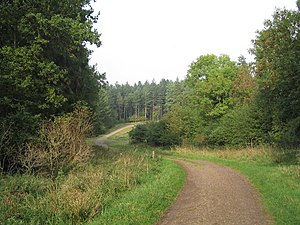Rockingham Forest: Difference between revisions
Created page with 'thumb|300px|A track through Fineshade Wood in the forest '''Rockingham Forest''' in Northamptonshire is a…' |
|||
| (One intermediate revision by the same user not shown) | |||
| Line 30: | Line 30: | ||
{{reflist}} | {{reflist}} | ||
[[Category:Forests]] | [[Category:Forests of Northamptonshire]] | ||
[[Category: | [[Category:Woods of Northamptonshire]] | ||
Latest revision as of 23:23, 21 March 2014

Rockingham Forest in Northamptonshire is a former royal hunting forest. It overspreads an area of some 200 square miles, lying between the River Welland and River Nene and the towns of Stamford and Kettering. It has a rich and varied landscape, with farmland, open pasture, pockets of woodland and villages built from local stone.[1]
History
The forest is named after the village of Rockingham, where the castle was a royal retreat. The boundaries were marked by the River Nene on the eastern side, and on the western side what is now the A508 road from Market Harborough to Northampton. Over the years the forest shrank and today only a patchwork of the north-eastern forest remains. The bulk of the remaining forest is located within a square, of which the corners are Corby, Kettering, Thrapston and Oundle.
The area became a royal hunting ground for King William I after the Norman Conquest. The term 'Forest' represented an area of legal jurisdiction and remained so until the 19th century.
A Cistercian abbey was established in 1143 which became known as Pipewell Abbey. In 1298 the de Lacys were granted permission to inclose 30 acres pertaining to the manor of Wadenhoe, lying within the Forest, in order to make a park.[2]
The forest boundaries were set in 1299, although the boundaries returned to a smaller area as a result of King Charles I's actions. King Charles II took little interest in the forest and gave away or sold much of it. By 1792 there was no significant royal ownership of the Forest area. Parliamentary enclosure of the bailiwicks and disafforestation of Rockingham bailiwick in 1832 resulted in a much smaller forest area with much of the land turned over to agriculture.
The Forestry Commission took over the remnants of public woodland in 1923.[1] The forest originally stretched from Stamford down to Northampton.
Management
Areas managed by the Forestry Commission include:
- Southey Wood, Peterborough
- Wakerley Great Wood
- Bedford Purlieus National Nature Reserve
- Fineshade Wood
- Fermyn Woods
The forest is well known for its population of Red Kites which now number over 300.
Outside links
References
- ↑ 1.0 1.1 "Rockingham Forest Trust". Rockingham Forest Trust. http://www.rockingham-forest-trust.org.uk/. Retrieved 25 August 2012.
- ↑ A History of the County of Northampton: Volume 3